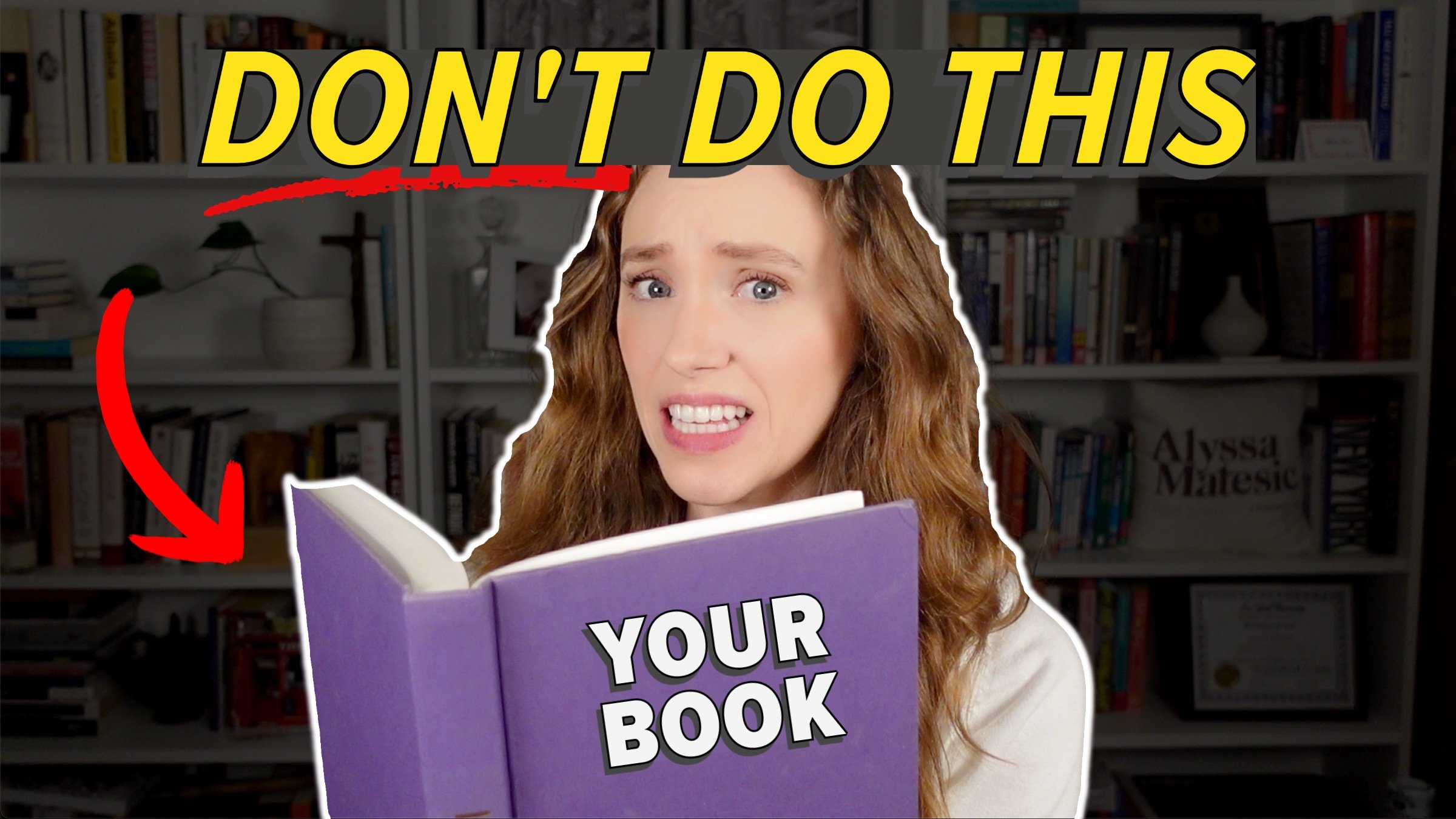Most Common Novel Writing Mistakes First-Timers Make
HIT PLAY OR READ THE POST BELOW:
Part of the reason writing a novel is uniquely difficult is because there's no singular tried-and-true method for it. Start to finish, everyone has their own subjective creative process, so if you want to be a novelist, you have to just jump into the deep end and figure out what works best for you.
That can be part of the fun of the process, but it’s also a large part of the challenge of your novel writing journey. The reality is, no matter how much or how little you prepare, you will likely make mistakes as you write your novel. This article will go over the most common novel writing mistakes and show you how to identify and fix them in your own manuscript.
These tips are coming from my experience working in the book publishing industry in the editorial department at two of the Big Five publishing houses and at a literary agency, as well as my experience as an independent developmental book editor mostly working with first-time authors.
So, what are the most common novel writing mistakes?
An Overcrowded Narrative
An overcrowded narrative occurs when the story just has too much going on, making it unfocused and ultimately not engaging to the reader. To be specific, this could mean too many points of view, too many secondary storylines or plotlines, or simply too large a cast of secondary characters that take attention away from the main protagonists.
Remember, you only have so much space to explore the plot within the confines of a novel, which is typically between 60,000 to 90,000 words. Within that length limit, you simply may not be able to do justice to as many of the characters or plotlines as you want to. Therefore, you have to be strategic and picky with what story you are going to tell in full, at least in this particular novel.
If you suspect that your novel has this issue, I challenge you to ask yourself the difficult questions: “Whose story is this?” and “Which characters are the most vital to the plot?” By identifying the main plotline, characters, and point of conflict, you’ll be able to then see which other subplots and side characters are actually distracting from the main narrative.
Your novel is going to be much more successful if you deeply immerse the reader in a priority narrative, rather than asking them to be superficially invested in several minor storylines. That doesn’t mean you can't have a multiple storyline novel, but in that case, it’s important that both storylines earn their place in the novel and the reader is able to see how the different stories are connected.
By prioritizing your main plotline, characters, and perspectives, you will give your story the space it needs to effectively engage the reader.
Unclear Character Motivations
As the writer, it's often crystal clear to you why your characters are doing what they're doing. After all, you know everything about them! You are in their head, or maybe they're speaking to you within yours, but remember: these motivations are not necessarily obvious to the reader.
It’s important that the reader understands the protagonists’ motivations, because this is what ultimately allows the reader to feel connected to the main characters and get invested in the story to see what happens to them. There might be a few situations where the reader doesn’t need to fully understand a character's motivations, such as if you wait to reveal an antagonist character’s evil motivations until the climax of the novel, but we should understand the protagonists’ underlying motivations and intentions throughout the story.
If you are writing in close third person or first person, you can show the reader a character’s motivations by having them reflect on what is going on around them in a given scene or even showing their thoughts verbatim. That way, the reader will literally see the internal thoughts behind their actions.
If you are writing in omniscient third person, typically you will convey the characters motivations through their interactions and dialogue with others. Of course, they might not always say exactly what is on their mind, but the combination of body language, dialogue, and built-up character traits will help inform the reader as to why your characters are doing the things they do.
The reason why character motivation is a crucial element of any novel is because if the reader doesn't understand why the protagonists are doing what they're doing, they will likely not care as much about the character and, as an extension, the story as a whole. Just like in real human relationships, readers need to understand a character’s underlying objectives in order to connect with them. Once a reader is connected to a character, they will want to see the story through to find out if they achieve their objectives.
The Bait and Switch
Another one of the most common novel writing mistakes first-time novelists make is what I call “bait and switch.” This happens when you set up the first 50 or so pages of the novel to follow a specific character, establishing a point of conflict with them that the reader gets hooked on.
But then, at some point, the novel abruptly switches and follows a completely different character or conflict, transforming the story into something else. An example of this mistake is if you introduce a new POV character halfway through the novel, who then takes over as the primary perspective the story follows. Another example is setting the novel at one time period, and then drastically skipping forward in time without ever returning to the initial setting.
To you as the author, this transition may make perfect sense, but a reader who is entering your story’s world and circumstances for the first time can get really thrown off by this writing technique. The reader will likely have gotten invested in what was presented at the beginning of the novel, so changing the focus of the story entirely can make them feel a bit cheated – especially if the second half of the book is less engaging to them.
To avoid this mistake, you want to make sure the first 50 pages of your novel are actually representative of the story to come. Make sure you introduce the primary characters and plotlines that are going to make up the bulk of the story.
If your novel involves a time skip because you need to establish a historical background for the novel, then I would challenge you to pull the main narrative forward instead and incorporate that historical background through it, either through exposition or through the characters’ dialogue.
In almost all cases, the primary narrative does need to be in the lead of the novel. This is because the bait and switch writing technique is very risky — again, if the reader is more invested in the beginning of the story than whatever the novel switches to, it can turn them off from the book entirely, which is the last thing any author wants.
Underdeveloped Character Relationships
Just like how the reader needs to understand the characters’ motivations and underlying objectives, they need to understand why the characters’ relationships look the way they do.
In most cases, at least some of your characters will have some kind of history that occurred prior to the start of the novel, so it is important to bring the reader up to speed on what has happened in their past. Whether they are close or have a fracture in their relationship, we should know what has led to the present state of the characters’ relationship. This way, the reader will be able to properly interpret the dynamics that they see in the novel.
For instance, if the protagonist in the present-day narrative clearly has a tense relationship with their mother, the reader should, at some point, learn what has led to that troubled relationship. It could be anything from a simple fight over a messy room to a complete betrayal of trust after the mother cheated on the father. By giving the reader a good sense of why a relationship is the way it is, it will also help them understand the characters as individuals more deeply.
Ideally, you would also show some kind of growth in the relationship across the course of the novel, especially if that relationship is troubled in some way. That doesn't mean the characters have to end up reconciling by the end, though — it can be just as satisfying for the reader to see another realistic conclusion, such as a character realizing that they're never going to have a good relationship with their mother and coming to an internal acceptance of that.
What you don't want to do is to leave these tense relationships unresolved without any acknowledgement or resolution by the end, because the reader will want to see a growth trajectory in your character relationships.
A Lackluster Ending
Another one of the most common novel writing mistakes is having an ending that falls flat. Your ending should have a strong enough sense of resolution, such that the reader doesn't have any lingering questions and can see a difference in the main characters from when the novel began to the novel’s ending. Depending on how the characters’ journeys progress, you’ll either want to illustrate how they have changed and learned, or how they haven’t changed and learned despite what happened to them in the story.
Ultimately, there should be some kind of arc such that we are in a different place at the end of the story than we were at the beginning
Remember, establishing resolution at the end of the narrative does not mean that you have to have a “happy ending,” by any means. The reader can get just as much resolution if the character doesn't set out what they had accomplished to do. So make sure to clue us in as to how the events of the novel have affected the main characters in one way or another, positive or negative.
Something else to consider is that the ending should also resolve any secondary points of conflict, such as character relationship issues like I mentioned above. If your main character has a big fight with someone close to them halfway through the novel and then we never see that character acknowledged again, the reader is going to wonder what happened. You want to make sure you thread all of those points of conflict through to the end and resolve each of them in some way.
I hope that learning about the most common novel writing mistakes helps you craft a stronger manuscript and feel more confident in your storytelling abilities!
Thanks so much for reading and happy writing!





